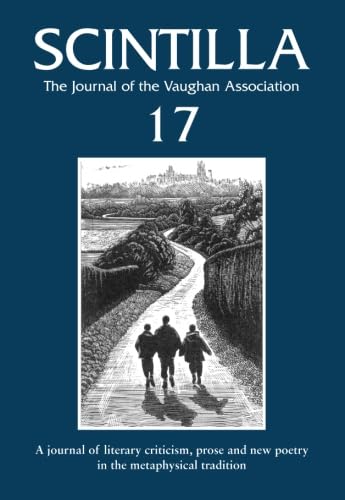Scintilla 17: The Journal of The Vaughan Association (Scintilla: The Journal of the Vaughan Association) - Softcover

Continuing its tradition of crossing the critical-creative divide, Scintilla 17 brings together the best literary scholarship, prose and new poetry both long and short. Scintilla was first published in 1997 by The Usk Valley Vaughan Association (now The Vaughan Association) founded in 1995 by a group of poets and literary scholars to mark the tercentenary of Henry Vaughan’s death, 23 April 1695. Since that time the journal’s distinctive combination of poetry, criticism and prose has been committed to exploring the interests and themes of its tutelary spirits, Henry the Poet-physician (1621-95) and his priest-alchemist brother Thomas (1621-66). Much in Scintilla 17 is devoted to the nature of poetry itself, poetic form and how poetry creates its effect, its modes and moods. Robert Wilcher leads with an exami- nation of Henry Vaughan’s penchant for lifting words, phrases and ideas without always mentioning his sources. Such ‘magpie borrowings’ have in the past drawn considerable critical dismay, but Wilcher calls for a ‘more discriminating critical vocabulary [...] to describe a poetic method that lies between direct “quotation” at one end of the spectrum and “plagiarism” at the other’. Vaughan, he concurs with M. M. Mahood, ‘controls, and is not controlled by, his borrowings’, invoking a ‘community of mutual knowledge’ between poet and reader. Naomi Marklew explores the elegaic mode of Silex Scintillans drawing parallels with well known seventeenth-century examples such as Milton’s ‘Lycidas’. Tony Brown’s essay turns attention to a more recent Welsh poet, R. S. Thomas, exploring a number of newly discovered ekphrastic poems that meditate upon a selection of surrealist images found in Thomas’s library. These, Brown finds, throw light on the private journey the poet undertook in his final years, engaging with his sense of uncertainty and displacement in a disconcerting world. Graham Parry introduces us to a lesser known 17th century poet, John Collop. A voice of nostalgia for king and church swept away by the civil wars, Collop exemplifies a note of disillusionment, pleased no doubt by the Restoration but unable to rejoice after the traumas of the Interregnum. Erik Ankerberg’s discussion of Ardour in the poetry of Wallace Stevens offers interesting reading alongside Christopher Norris’s verse essay. Both explore the ways in which poetry creates its effects. Stevens’s insistence, according to Ankerberg, that ardour is an essential quality of the experience of poetry by both poet and reader. Norris reflects more widely on a critical debate set between the ‘warring poles’ of high formalist poetic demands and the ‘unbuttoned self-reflection’ characteristic of confessional poetic modes. Through strict rhyming stanzas, Norris’s poetic essay gives a strongly ironic commemoration of Veronica Forrest-Thomson who, despite her formalist objections to the confessional mode poetry, shaped from such a ‘storm / Of inchoate emotion’, in the end followed the likes of Plath in suicide revealing her own rather messy processes of poetic expression. Jeremy Hooker rounds off this issue with a look at two Welsh writers, Ruth Bidgood and Christopher Meredith. ‘Heartlands’ is a thoughtful meditation on poetry that ‘translates’ the material places of Wales and finds particular meaning in the ‘border- lands’, the poetry of edges, for ‘edges are where meanings happen’. There are many poems here that respond to place – two, for instance, on Abbey Dore where, for Patrick Bond, the place seems to ‘Hold clouds in a halo of light’ while Jeremy Hooker finds ‘the Green Man’ is at home there ‘among broken things’.Language, its drifts and restorations, is an abiding theme, as is the creaturely life that teems through the poems as fox, fly, bird, beetle, spider, bee in keeping with Henry Vaughan’s encouragement in Silex I to ‘Walk with thy fellow-creatures: note the hush / And whispers amongst them’, each an expression of the ‘I Am’ (‘Rules and Lessons’).
"synopsis" may belong to another edition of this title.
- PublisherCreateSpace Independent Publishing Platform
- Publication date2013
- ISBN 10 1494739429
- ISBN 13 9781494739423
- BindingPaperback
- Number of pages220
- EditorAnkerberg Dr Erik, Owen Fiona, Thomas Dr Peter
Buy New
Learn more about this copy
US$ 21.57
Shipping:
US$ 12.49
From United Kingdom to U.S.A.
Top Search Results from the AbeBooks Marketplace
Scintilla 17: The Journal of The Vaughan Association (Scintilla: The Journal of the Vaughan Association)
Published by
CreateSpace Independent Publishing Platform
(2013)
ISBN 10: 1494739429
ISBN 13: 9781494739423
New
Paperback
Quantity: 1
Seller:
Rating
Book Description Paperback. Condition: Brand New. 17 edition. 220 pages. 8.27x5.71x0.50 inches. This item is printed on demand. Seller Inventory # zk1494739429
Buy New
US$ 21.57
Convert currency

